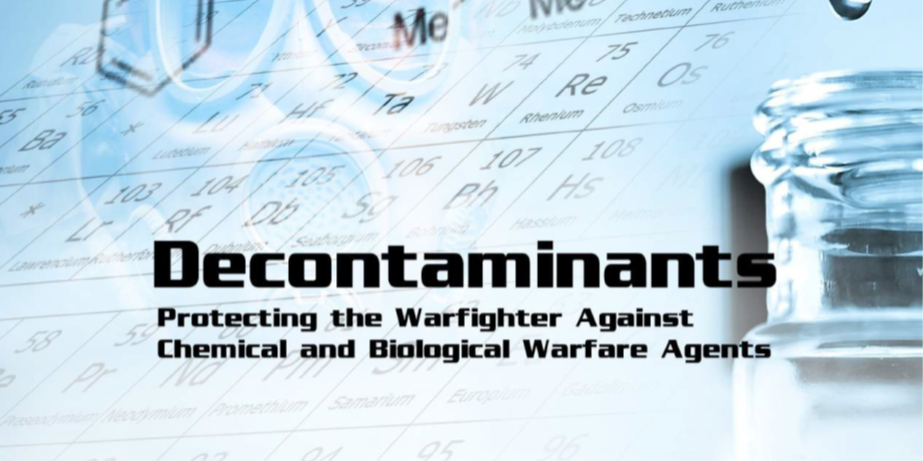Effective decontamination technology is an ongoing need for the Department of Defense as crude weapons utilizing biological and chemical payloads are readily fashioned from non-military technology. Despite global restrictions on the production and stockpiling of chemical and biological warfare agents [1], many precursors required to fashion a crude chemical weapon remain widely available as industrial chemicals [2], while widespread research of common virus strains creates opportunity for purchase or theft to facilitate the creation of a biological weapon [3].
Some of these agents, particularly chemical agents, linger or leave residue behind, which requires decontamination prior to human re-occupancy of the area. Thus, the DoD supports new and innovative research that will protect the warfighter against chemical and biological warfare agents.
Scientists have developed a new water-based decontaminant solution effective against both classical chemical and biological warfare agents. Registered with the Environmental Protection Agency under the Federal Insecticide Fungicide and Rodenticide Act, the technology claims efficacy against bacterial spores, including anthrax and overcomes long-standing challenges in storage and transport of decontamination solutions.
Decontaminants used to treat surfaces contaminated with chemical and biological warfare agents must be stable so they can be stored for long periods and stockpiled for times of need. They must also be non-reactive so that they are environmentally benign and can be safely handled by personnel and rapidly transported. At the same time, the decontaminant must be very reactive upon use so that it can quickly detoxify chemical warfare agents and sterilize bacterial spores.
These conflicting requirements for stability and reactivity are addressed by a new technology that stores and transports a solid salt, which when needed is dissolved in water and activated just as it is applied to produce a reactive, fast acting, decontaminant solution.
The solution is applied directly onto a contaminated surface through a miniaturized electrochemical cell, producing reactants that act quickly and then decompose. One of the primary reactants is chlorine dioxide, a highly effective antimicrobial. The electrochemically generated chlorine dioxide, eClO2, effectively detoxifies chemical agents HD (mustard agent) and VX (nerve agent) as well as biological agents such as anthrax.
Other reactive components are simultaneously produced to provide reactive efficacy against G-class nerve agents. This solution provides the DoD an effective means to decontaminate chemical and biological warfare agents and keep the warfighter safe.
The decontaminant is stored in its most concentrated form, as a powder solid and maximum concentration liquid surfactant. This approach minimizes the size of the storage facility and the effort required to transport the material to locations of need. These starting materials are non-hazardous (salt and soap), and can be shipped in large quantities using military or civilian air transport. Water does not need to be shipped in to dissolve the solid materials. It can be acquired locally, and can include water taken directly from lakes or rivers or even seawater.
The decontaminant materials are inexpensive, commonly used industrial materials that are available in bulk. The fact that salts are used as the starting materials ensures a long shelf life. The applicators are operated with complete portability using lithium primary batteries (with a 10-year shelf life) or rechargeable batteries. The units can also be plugged into a 12 volt generator, vehicle, or powered from the electrical grid.
This eClO2 technology has demonstrated efficacy against chemical warfare agents in tests at the Edgewood Chemical and Biological Center, and was recently registered with the EPA under the Federal Insecticide, Fungicide and Rodenticide Act as effective against bacterial spores, including anthrax (EPA Reg. No. 85797-1). Scientists at the Naval Surface Warfare Center Dahlgren Division completed efficacy testing against a 1×107 colony-forming unit Bacillus anthracis Ames (anthrax) challenge. The virulent anthrax was eliminated within one-minute contact time. [4]
References
1. International Committee of the Red Cross. (2013, August 04). Chemical and biological weapons. Retrieved from https://www.icrc.org/eng/war-and-law/weapons/chemical-biological-weapons/overview-chemical-biological-weapons.htm (accessed April 06, 2016).
2. Bennett, M. (2003). TICs, TIMs, and Terrorists. Today’s Chemist at Work, 12(4), 21-25. Retrieved from http://pubs.acs.org/subscribe/archive/tcaw/12/i04/pdf/403regulations.pdf accessed April 06, 2016).
3. Danzig, R. (2005). Proliferation of Biological Weapons into Terrorist Hands, The challenge of proliferation: A report of the Aspen Strategy Group. (pp. 68-70), Washington, D.C.: The Aspen Institute. Retrieved from http://www.aspeninstitute.org/sites/default/files/content/docs/asg/ asgdanzigchallenge.pdf (accessed April 06, 2016).
4. Buhr, T.L, Young, A.A., Minter, Z.A., Wells, C.M., and Shegogue, D.A. (2011). Decontamination of a hard surface contaminated with Bacillus anthracis ΔSterne and B. anthracis Ames spores using electrochemically generated liquid-phase chlorine dioxide (eClO2). J. Appl. Microbiol., 111, 1057-1064.
Brian France holds a Ph.D. in Analytical Chemistry and works to bridge fundamental science and customer needs to develop new commercial products. Dr. France is a Senior Scientist at TDA Research and a Principal Investigator currently leading several R&D efforts. Dr. France has been involved in chemical defense and decontamination R&D for the past decade and is an honorably discharged veteran of the U.S. Army. TDA Research, Inc. is a privately owned small business with significant research and development capabilities. TDA develops technology and manufactures advanced materials, chemical processes, and aerospace and military hardware. TDA has a history of maturing technologies from concept to ton size production.


